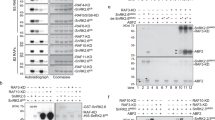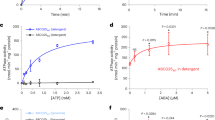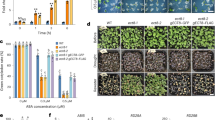Abstract
The phytohormone abscisic acid (ABA) regulates the expression of many genes in plants; it has critical functions in stress resistance and in growth and development1,2,3,4,5,6,7. Several proteins have been reported to function as ABA receptors8,9,10,11,12,13, and many more are known to be involved in ABA signalling3,4,14. However, the identities of ABA receptors remain controversial and the mechanism of signalling from perception to downstream gene expression is unclear15,16. Here we show that by combining the recently identified ABA receptor PYR1 with the type 2C protein phosphatase (PP2C) ABI1, the serine/threonine protein kinase SnRK2.6/OST1 and the transcription factor ABF2/AREB1, we can reconstitute ABA-triggered phosphorylation of the transcription factor in vitro. Introduction of these four components into plant protoplasts results in ABA-responsive gene expression. Protoplast and test-tube reconstitution assays were used to test the function of various members of the receptor, protein phosphatase and kinase families. Our results suggest that the default state of the SnRK2 kinases is an autophosphorylated, active state and that the SnRK2 kinases are kept inactive by the PP2Cs through physical interaction and dephosphorylation. We found that in the presence of ABA, the PYR/PYL (pyrabactin resistance 1/PYR1-like) receptor proteins can disrupt the interaction between the SnRK2s and PP2Cs, thus preventing the PP2C-mediated dephosphorylation of the SnRK2s and resulting in the activation of the SnRK2 kinases. Our results reveal new insights into ABA signalling mechanisms and define a minimal set of core components of a complete major ABA signalling pathway.
This is a preview of subscription content, access via your institution
Access options
Subscribe to this journal
Receive 51 print issues and online access
$199.00 per year
only $3.90 per issue
Buy this article
- Purchase on SpringerLink
- Instant access to full article PDF
Prices may be subject to local taxes which are calculated during checkout




Similar content being viewed by others
Change history
03 December 2009
Two of the labels on Fig. 1b were corrected on 3 December 2009.
References
Zhu, J. K. Salt and drought stress signal transduction in plants. Annu. Rev. Plant Biol. 53, 247–273 (2002)
Hetherington, A. M. Guard cell signaling. Cell 107, 711–714 (2001)
Schroeder, J. I., Kwak, J. M. & Allen, G. J. Guard cell abscisic acid signalling and engineering of drought hardiness in plants. Nature 410, 327–330 (2001)
Finkelstein, R. R., Gampala, S. S. & Rock, C. D. Abscisic acid signaling in seeds and seedlings. Plant Cell 14 (Suppl). S15–S45 (2002)
Koornneef, M., Bentsink, L. & Hilhorst, H. Seed dormancy and germination. Curr. Opin. Plant Biol. 5, 33–36 (2002)
Roelfsema, M. R. G. & Hedrich, R. In the light of stomatal opening—new insights into ‘the Watergate’. New Phytol. 167, 665–691 (2005)
Nemhauser, J. L., Hong, F. & Chory, J. Different plant hormones regulate similar processes through largely nonoverlapping transcriptional responses. Cell 126, 467–475 (2006)
Shen, Y. Y. et al. The Mg-chelatase H subunit is an abscisic acid receptor. Nature 443, 823–826 (2006)
Liu, X. et al. G protein-coupled receptor is a plasma membrane receptor for the plant hormone abscisic acid. Science 315, 1712–1716 (2007)
Pandey, S., Nelson, D. C. & Assmann, S. M. Two novel GPCR-type G proteins are abscisic acid receptors in Arabidopsis . Cell 136, 136–148 (2009)
Ma, Y. et al. Regulators of PP2C phosphatase activity function as abscisic acid sensors. Science 324, 1064–1068 (2009)
Park, S. Y. et al. Abscisic acid inhibits type 2C protein phosphatases via the PYR/PYL family of START proteins. Science 324, 1068–1071 (2009)
Santiago, J. et al. Modulation of drought resistance by the abscisic acid-receptor PYL5 through inhibition of clade A PP2Cs.Plant J. 10.1111/j.1365–313X.2009.03981.x (2009)
Li, S., Assmann, S. M. & Albert, R. Predicting essential components of signal transduction networks: a dynamic model of guard cell abscisic acid signaling. PLoS Biol. 4, e312 (2006)
McCourt, P. & Creelman, R. The ABA receptors–we report you decide. Curr. Opin. Plant Biol. 11, 474–478 (2008)
Pennisi, E. Stressed out over a stress hormone. Science 324, 1012–1013 (2009)
Mustilli, A. C., Merlot, S., Vavasseur, A., Fenzi, F. & Giraudat, J. Arabidopsis OST1 protein kinase mediates the regulation of stomatal aperture by abscisic acid and acts upstream of reactive oxygen species production. Plant Cell 14, 3089–3099 (2002)
Yoshida, R. et al. ABA-activated SnRK2 protein kinase is required for dehydration stress signaling in Arabidopsis . Plant Cell Physiol. 43, 1473–1483 (2002)
Yoshida, R. et al. The regulatory domain of SRK2E/OST1/SnRK2.6 interacts with ABI1 and integrates abscisic acid (ABA) and osmotic stress signals controlling stomatal closure in Arabidopsis . J. Biol. Chem. 281, 5310–5318 (2006)
Fujii, H., Verslues, P. E. & Zhu, J. K. Identification of two protein kinases required for abscisic acid regulation of seed germination, root growth, and gene expression in Arabidopsis . Plant Cell 19, 485–494 (2007)
Fujii, H. & Zhu, J. K. Arabidopsis mutant deficient in three abscisic acid-activated protein kinases reveals critical roles in growth, reproduction and stress. Proc. Natl Acad. Sci. USA 106, 8380–8385 (2009)
Johnson, R. R., Wagner, R. L., Verhey, S. D. & Walker-Simmons, M. K. The abscisic acid-responsive kinase PKABA1 interacts with a seed-specific abscisic acid response element-binding factor, TaABF, and phosphorylates TaABF peptide sequences. Plant Physiol. 130, 837–846 (2002)
Furihata, T. et al. Abscisic acid-dependent multisite phosphorylation regulates the activity of a transcription activator AREB1. Proc. Natl Acad. Sci. USA 103, 1988–1993 (2006)
Belin, C. et al. Identification of features regulating OST1 kinase activity and OST1 function in guard cells. Plant Physiol. 141, 1316–1327 (2006)
Rubio, S. et al. Triple loss of function of protein phosphatases type 2C leads to partial constitutive response to endogenous abscisic acid. Plant Physiol. 150, 1345–1355 (2009)
Kuhn, J. M. & Schroeder, J. I. Impacts of altered RNA metabolism on abscisic acid signaling. Curr. Opin. Plant Biol. 6, 463–469 (2003)
Hirayama, T. & Shinozaki, K. Perception and transduction of abscisic acid signals: keys to the function of the versatile plant hormone ABA. Trends Plant Sci. 12, 343–351 (2007)
Yoo, S.-D., Cho, Y.-H. & Sheen, J. Arabidopsis mesophyll protoplasts: a versatile cell system for transient gene expression analysis. Nature Protocols 2, 1565–1572 (2007)
Van Veldhoven, P. P. & Mannaerts, G. P. Inorganic and organic phosphate measurements in the nanomolar range. Anal. Biochem. 161, 45–48 (1987)
Walter, M. et al. Visualization of protein interactions in living plant cells using bimolecular fluorescence complementation. Plant J. 40, 428–438 (2004)
Acknowledgements
We thank R. Bressan for helpful discussions and for editing of the manuscript. This work was supported by National Institutes of Health grants (J.-K.Z.) and MICIIN and CSIC fellowships (S.R. and R.A.).
Author Contributions H.F. contributed Figs 2a–c, e, 3, 4a–c and Supplementary Fig. 4. V.C. contributed Fig. 1a–d and Supplementary Fig. 1a, b. A.R., S.R., R.A. and P.L.R. contributed Fig. 2d and Supplementary Figs 2 and 3. S.-Y.P. and S.R.C. assisted with the generation of recombinant proteins, and S.R.C. helped edit the manuscript. J.S. assisted with protoplast assays. J.-K.Z. designed the experiments, and wrote the paper together with V.C. and H.F.
Author information
Authors and Affiliations
Corresponding author
Supplementary information
Supplementary Figures
This file contains Supplementary Figures 1-4 with Legends. (PDF 571 kb)
Rights and permissions
About this article
Cite this article
Fujii, H., Chinnusamy, V., Rodrigues, A. et al. In vitro reconstitution of an abscisic acid signalling pathway . Nature 462, 660–664 (2009). https://doi.org/10.1038/nature08599
Received:
Accepted:
Published:
Issue Date:
DOI: https://doi.org/10.1038/nature08599
This article is cited by
-
MKK3 Cascade Regulates Seed Dormancy Through a Negative Feedback Loop Modulating ABA Signal in Rice
Rice (2024)
-
Navigating Through Harsh Conditions: Coordinated Networks of Plant Adaptation to Abiotic Stress
Journal of Plant Growth Regulation (2024)
-
Molecular characterization reveals that OsSAPK3 improves drought tolerance and grain yield in rice
BMC Plant Biology (2023)
-
CePP2C19 confers tolerance to drought by regulating the ABA sensitivity in Cyperus esculentus
BMC Plant Biology (2023)
-
Transcriptome and metabolome analysis reveals key genes and secondary metabolites of Casuarina equisetifolia ssp. incana in response to drought stress
BMC Plant Biology (2023)



